
With November comes cool weather and all things warm and woolly! Among everything I love to do, knitting is high on my list. I’ve been teaching knitting and crochet classes for over a decade, and always have several projects going at any given time. I love everything about knitting: the anticipation of starting a new project, the way the needles sound together, the portability, the different items that can be made and the delicious yarn! A good yarn and its texture can make all the difference in a project.
As a child, at my aunt’s house, I would always wander into her front room where she had a large antique spinning wheel displayed. I’d never dare touch – (it was a thing of fairy tales!) but admired with awe! I still think spinning wheels are stunning, but never really knew exactly how they create the intoxicating yarns that call out to us knitters until recently- when I was treated to “Spinning Wheel 101” by a very talented spinner and alpaca farmer.

How many times have you said, “When I retire someday I want to live on a farm”? June and Henry Bissonnette are living that dream in Connecticut, having converted the property their home sits on into a beautiful farm where they live with their six alpacas, four cats, and a parrot. Henry, a fellow Master Gardener, and his wife June were not always alpaca farmers.
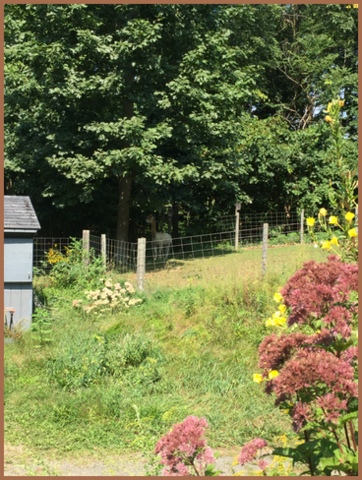
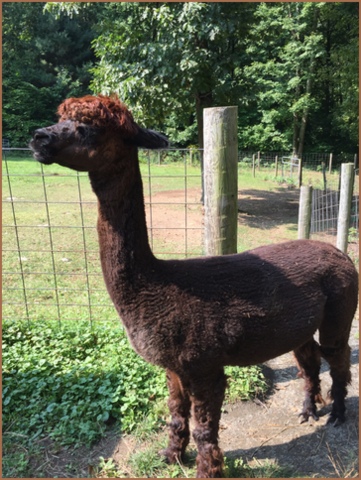
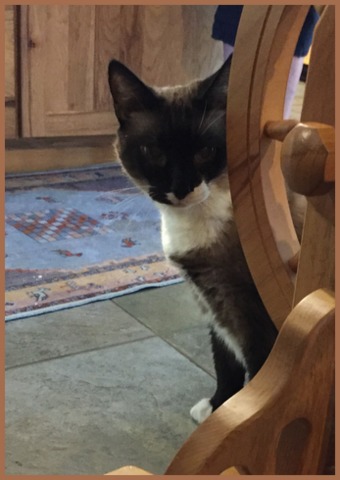
In 2004, June was two years away from retirement when they went camping with relatives at Lake Champlain. Terrible weather forced them to cancel outdoor plans, so they went to a craft show at the Saratoga Racetrack. There they saw an Alpaca and Llama agility competition. June had never seen alpacas before and thought they were the cutest animals she’d ever seen. It was love at first sight, and June knew right then and there that she wanted to raise them someday.

After that, June and Henry could not forget alpacas. June was a Senior Risk Analyst for GE Capital at the time, so for the next two years, the couple visited an alpaca farm in Ballston Spa, New York, and subscribed to Alpaca Magazine. The couple took free time to clear their property of brush, to plant pastures, put up fencing and gather supplies needed to be a working alpaca farm. In the fall of 2006, Lavender Creek Farm was born.
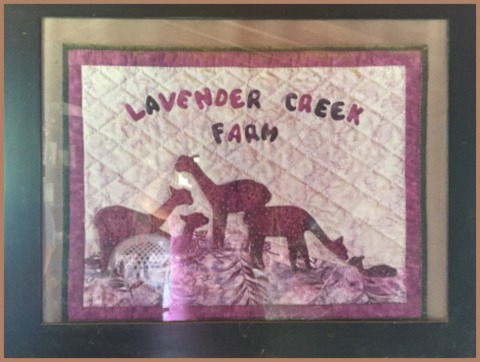
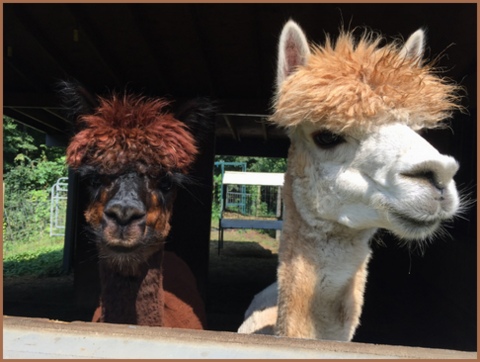
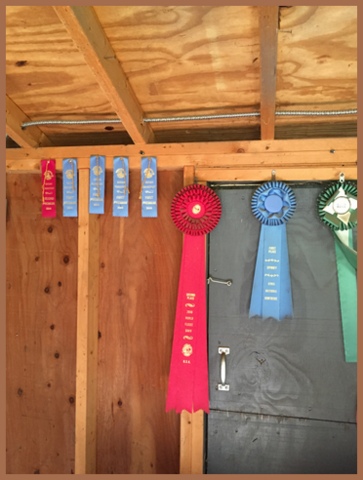
Some of the alpaca’s winning ribbons
Henry and June started with three alpacas and currently have six that call Lavender Creek Farm home. They didn’t plan on that number, but have had babies born on their farm and adopted from friends who were downsizing.
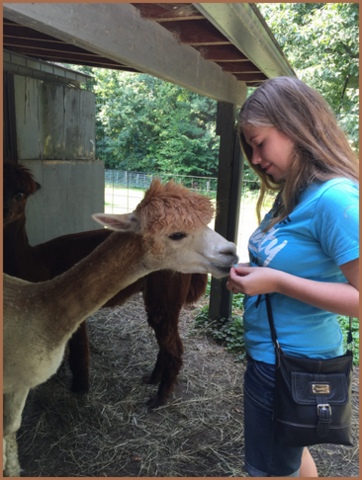
Audrey enjoyed our visit, and loved feeding treats.
What makes alpaca wool so special (and pricier in stores than other fibers) is that alpaca wool has fine “scales”. Scales hold fiber together. Alpaca has fewer scales than wool, so it has more of a feeling like fine cashmere. The final product of alpaca is a hollow fiber, lighter than wool, that is stain resistant and hypoallergenic. The firmness of a fiber is the micron count. The micron count of wool-bearing animals ranges from 21 – 30 microns. Cashmere has 12 microns, while alpacas having a count of 12 – 30. Juniper and Darcy, younger animals on the farm, have counts in the low 20’s, while Siobahn, an older alpaca has a count of around 30.
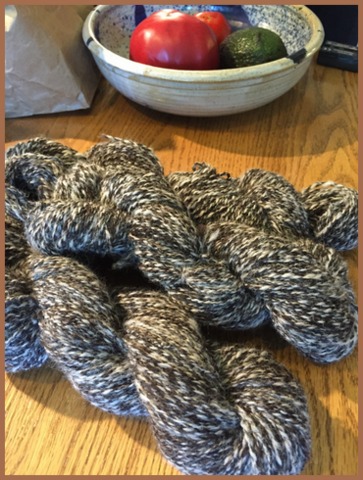
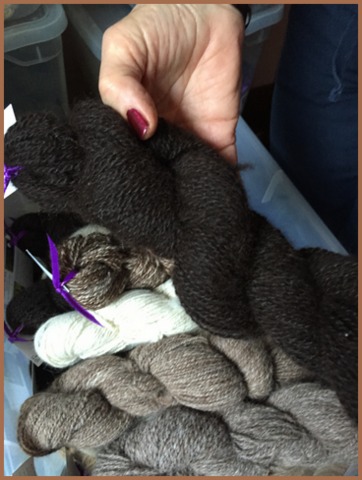
June’s spun alpaca yarn is all natural, with no dyes
To process their animals’ wool, they shear the “blanket” across the back. This is known as “firsts”, which is the best, finest and most uniform of fiber. It is then sent to a local mill for washing and carding and finally made into roving. “Seconds” are made into rug yarn using alpaca-wrapped wool cord blended with wool to help shorter fibers hold together.
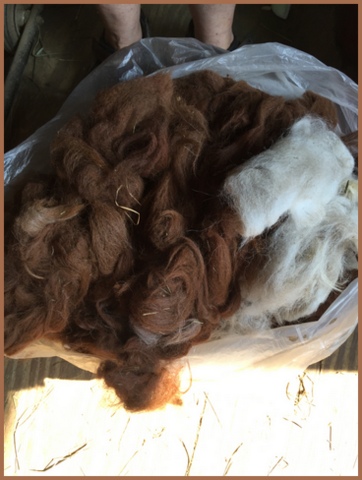
Seconds to be picked and spun
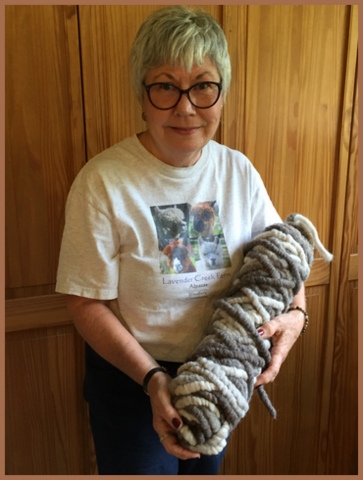
Rug yarn

30 Pounds of roving to be spun being checked out by the “inspectors” – Photo courtesy of June Bissonnette
Now a talented spinner who knits, crochets and weaves, at first, June could crochet but did not know how to spin or knit. She called a local spinner who gave her a lesson. June ordered her first spinning wheel and has now been spinning for ten years.
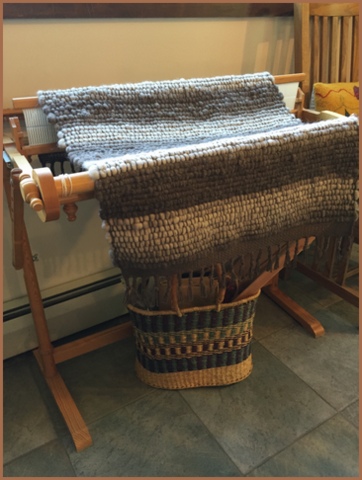
Some of June’s weaving
When you walk through the front door of their beautiful home, visitors notice two things: the couple’s adorable, pure-bred adopted Snowshoe Siamese kitties, and a big, stunning, wooden antique spinning wheel, known as a “Michel Cadorette”. Made in the 19th century by the well-known Canadian spinning wheel maker, this model is a single treadle. Spinning wheels were prolific in Canada in the 1800’s because all materials were spun in cottage industries. This model has tiny bobbins and spins fast, producing a very fine yarn.
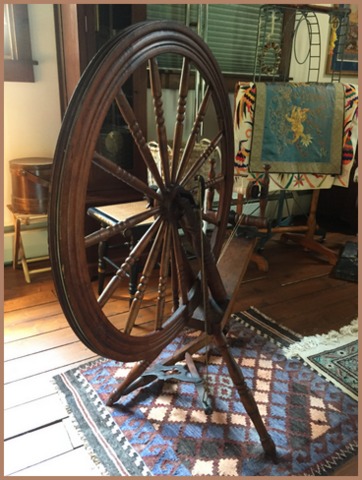
The very beautiful Michel Cadorette antique spinning wheel
Modern spinning wheels are not as large. Still beautiful, they take up much less room. June’s first wheel was an Ashford “Kiwi”, made in New Zealand. This is a good “starter” wheel. June says it “takes practice, practice, practice” to get the hang of spinning a good yarn. “You can take 100 lessons, but the way you really learn to spin is you practice.” The hardest thing to learn is consistency. Lumpy yarn becomes like “boucle”. The “Kiwi” is a basic wheel style called a “castle” because of the direction of the wheel. It takes up less space and is a double treadle.
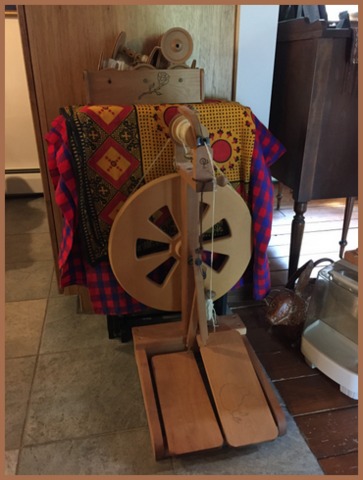
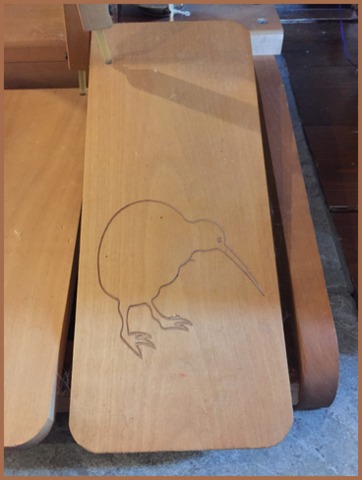
Treadling at a high speed results in a fine yarn, low speeds create thicker yarn.
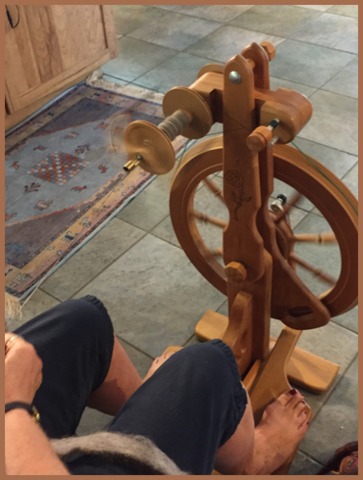
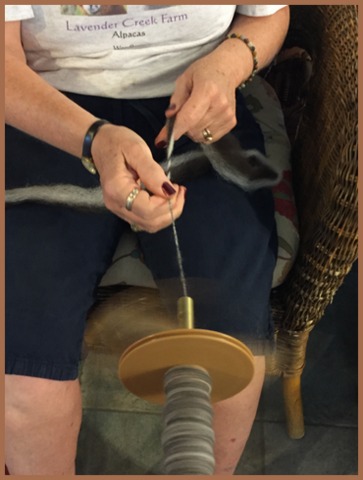
Thickness is also affected by how fast you treadle and how fast you “draft”, or feed the fiber into the wheel, and also by how much you draft. “Ratio” of a spinning wheel refers to how fast you can spin. First, you “spin” in one direction, next you “ply” it in another. A “lazy kate” is used to hold multiple bobbins while the yarn on them is wound off, twisting the fiber together so it becomes “2 ply”; it keeps spools or bobbins in place while spinning the yarn off of them. A “knotter” is used after the spool is full, making yarn into a skein.
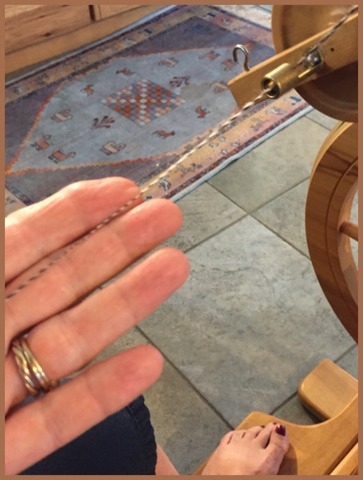
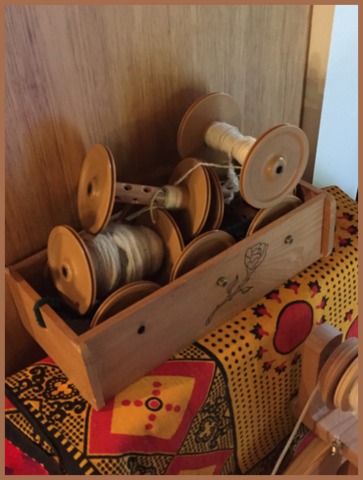
June’s Lazy Kate sits with various bobbins that go with her “Rose” spinning wheel.
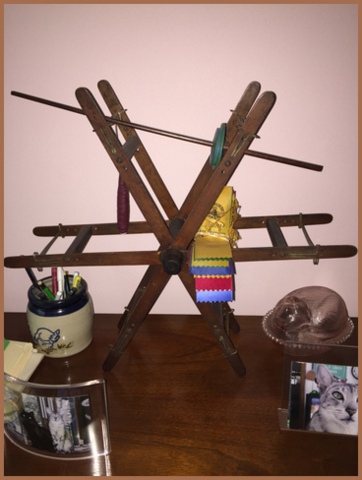
An antique skein winder now used as a display
June’s main spinning wheel is also made in New Zealand. Called a “Majacraft Rose”, it folds up and features 27 different ratio settings.
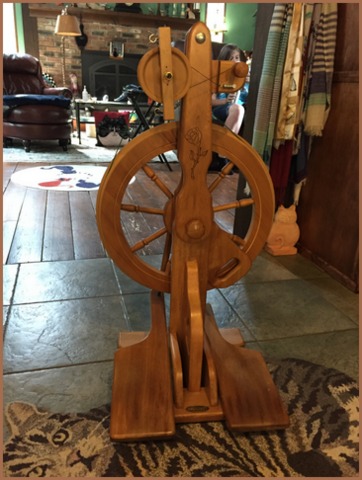
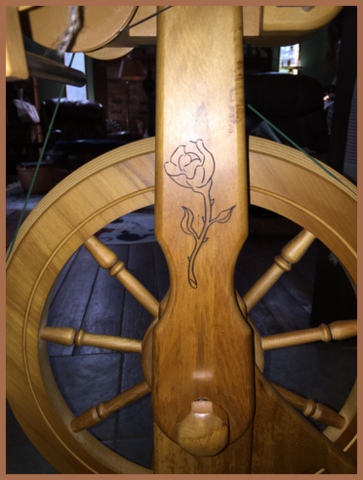
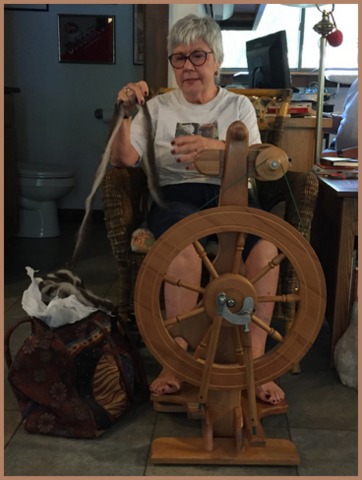
June says spinning is relaxing, and after ten years can watch television and spin, as she spins now by “feel”. I find knitting to be relaxing, too. I always say it is “my yoga”. (I can’t do yoga. I can’t stop thinking of things like my grocery list, and I have never been that flexible no matter how hard I try. Last time I tried, I lost my balance and fell through drywall). So I knit. Now, when I hold that soft, hand-spun sumptuous ball of color, I will have a new appreciation for how it came to be.
Until Next Time…Farmgirl Hugs, Nicole


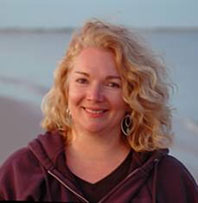
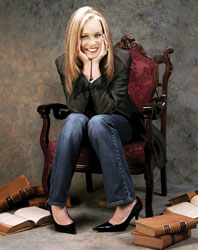

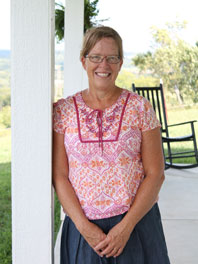
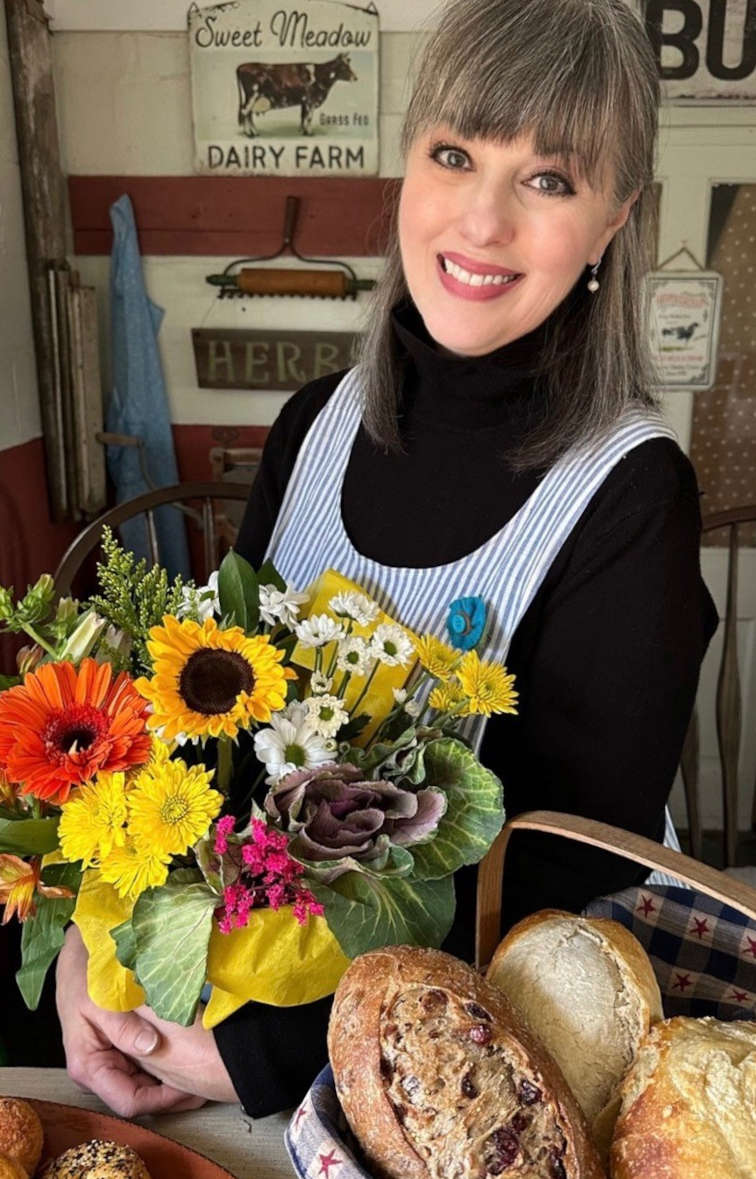
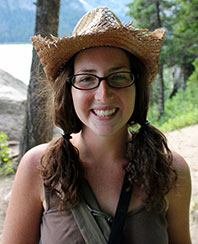
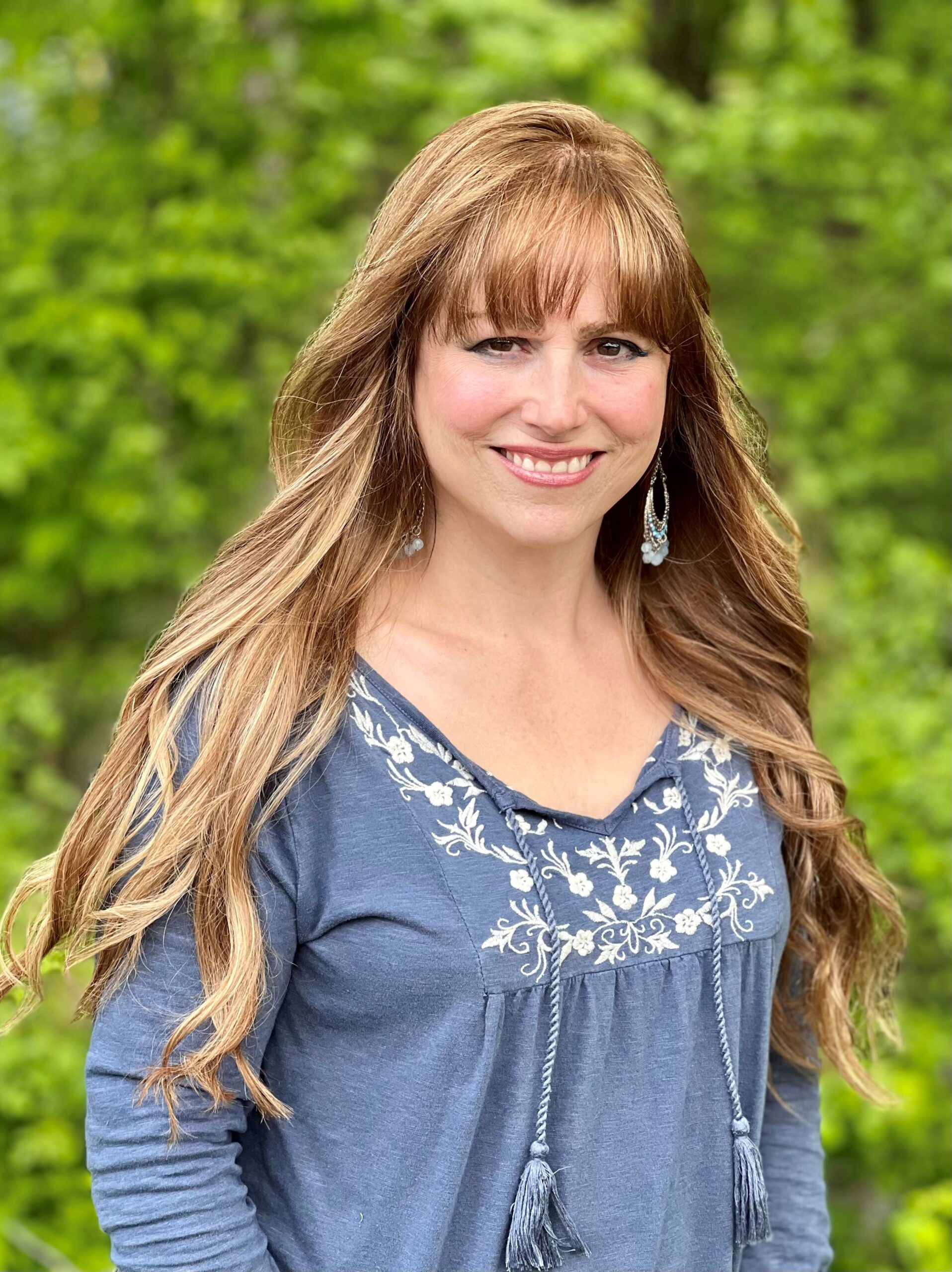
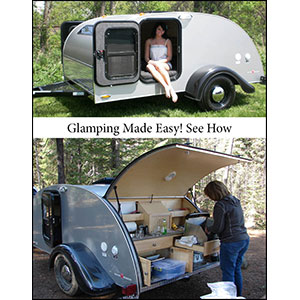

Very interesting!
Thank you, Kathryn! Glad you enjoyed this post. Farmgirl Hugs, Nicole
Great and informative blog. I love to knit & crochet although I do relatively easy projects. I can knit dishcloths and watch TV at same time.
Happy handwork to you, Becky
Hi Becky, “Easy” projects are great – you’re still a knitter! I love a good easy project so I can just “zen” with my handiwork, too. Glad you enjoyed the blog! Farmgirl Hugs, Nicole
Wow! This was some fascinating information! I would love to give it a try some time. I have heard of turning dog hair into yarn as well. Since I have an Alaskan Malamute I have plenty of hair I could use! Now just to learn how to spin and I can have my very own yarn. Thanks for sharing!
Hi Krista, Glad you liked it. I read a book with short stories for knitters once. One woman spun her dog hair and made a sweater. By the end of the story, I was rolling with laughter. She got caught in the rain! Farmgirl Hugs, Nicole
Loved this blog!! Now I too will appreciate all the hard work involved in creating alpaca yarns and why the price of an alpaca sweater might be a bit higher than mass produced garments. So worth it!! Thanks again! Judy
Hi Judy, I feel the same. I am making an alpaca ruffled scarf right now. It is so soft! I will really appreciate the yarn more, too! Farmgirl Hugs, Nicole
Thank you for this interesting post. Happy knitting.
Marilyn
Hi Marilyn! So glad you enjoyed it. It was fun to learn about spinning from June, and their animals were so sweet! Farmgirl Hugs, Nicole
I love the article. I had a friend here who is a master spinner. Just miles down the road from me is an alpaca farm, and the couple spins their own yarns. The wife knits the yarn into the most beautiful things. Thanks, Nicole!
Hi Marrietta! Thank you for reading and commenting; so glad you enjoyed this visit to Henry and June’s Farm. I am so in awe of knitters who spin their own yarn. Such a talent! Farmgirl Hugs, Nicole
Hi Nicole,
I’m a spinner and weaver since the 80’s and a member of a weavers & spinners guild here in the Dayton area. I believe you really mean a “niddy-noddy” and not a “knotter”. After you ply the two bobbin yarns together you wind the finished yarn onto the niddy-noddy and take it off to twist into a skein of yarn. There are so many terms used that originated back through the centuries. Hey, you did real well on explaining what you learned! I am currently spinning Akela’s fur. She was a FEMA rescue dog, an Australian sheep-herding dog of my friend and she passed away. He had kept her combings and it is making a lovely yarn. I was told that once the skein of yarn is gently washed of the oils and dander it shouldn’t smell of “wet dog” if it gets wet again. It is called “Chiengora” (French) when made into yarn. He wants it made into a lap throw so he can feel he is hugging his beloved dog again. Yours, Ellen
Hi Ellen! Thank you so much for explaining the “niddy-noddy”! I wondered if I had it wrong when I didn’t see much on the term “knotter” when I googled it. I am glad to know that it is possible to wash the “dog smell” away from spun canine fur, but if you come across that book, that story is hilarious. I wouldn’t mind having something made from my dog’s fur. She is older and is not doing so great. 🙁 I think it is sweet you are spinning that yarn for your friend. Thank you for sharing so much knowledge with us; very interesting! Farmgirl Hugs, Nicole
I would love to have a sweater made from Alpaca wool. My grandmother could knit and crochet, but I do not have the time or the patience.
Hi Carol, Alpaca wool is so very soft and warm! My grandmother could knit and crochet too, like me, but my mom never wanted to. She doesn’t have the patience either, lol! Thanks for reading and commenting! Farmgirl Hugs, Nicole
Love this, I always wanted to learn to spin. May have to rekindle that interest. 🙂 Thanks for sharing and as always, Be BLessed. NEta.
Hi Neta! So glad you liked this blog. It was fun to learn about and watch a spinner in action. Let me know if you start spinning! Farmgirl Hugs, Nicole
Hi Nicole –
Loved this story – saw the word Spinning and you caught my attention right away. I always wanted to learn, so I took a class at the Wool and Sheep Show in Rhinebeck, NY. The teacher was great and very patient, but now I realize just how much practice goes into spinning, but it is such a great craft to learn. Wheels are expensive and so I haven’t bought one yet. You also need a lot of time at the beginning to practice, practice, practice – maybe even with a glass of wine for those like me that get frustrated. 🙂 I love to crochet and started a Prayer Shawl Ministry at my church. Knitting is fun too, but I just don’t like to purl and have to get over that. Maybe you can include some simple but handy crochet and knitting projects in another email. Have a wonderful day!
Diane
Hi Diane! How are you? I was thinking about you the other day when I took my niece who was in town to the FDR house and Hyde Park. I would love to get to that Wool and Sheep show sometime! Do you know when it is this year? Maybe one of these days you and I will meet and I can help you with your purling! Thanks for reading and commenting, Farmgirl Hugs, Nicole
when I was little I got to see my great aunt spinning yarn at her spinning wheel. she was FAST and I was shocked at how fast it could go. I’m so glad I got to see her in action! loved reading your post, very interesting and informative!!
Hi Denise! How awesome is that, that you got to experience your great aunt spinning. It is amazing how fast they spin! What a great memory, thanks for sharing. Farmgirl Hugs, Nicole
Loved this article! I’ve been a “beginning” knitter for over 12 years now. I don’t want to think, just relax while my needles move. A little crochet mixed in there, too. I didn’t know alpaca is hypoallergenic. I’ve always avoided ANY wools because I break out out in a rash. A new world of yarn has opened up for me after reading this! (As if I don’t have enough already.) Thanks!
Hi Susan! If you are knitting anything,especially for 12 years, you are a KNITTER, Lol! I always tell my students that. You don’t have to be knitting a Norwegian Fair Isle type sweater to be a knitter. 🙂
I am so glad you enjoyed this article! Thank you for reaching out! Farmgirl Hugs, Nicole
Very good!
Thank you! xoxo Nicole
Great blog! Many a year ago I learned how to spin the Native American way – like you said – it was my yoga too and still is. Thanks for the blog. God bless
Hi Joan, Wow! What is the “Native American” way? Sounds interesting! Farmgirl Hugs, Nicole
So very interesting Nicole. Thank you for all the info and the photos. I’d no idea of the process at all and everything that’s involved to make beautiful wool. Incredible.
Hi Denise, Before I interviewed June, I didn’t either. What a great talent she possesses. So glad you enjoyed the blog! Farmgirl Hugs, Nicole